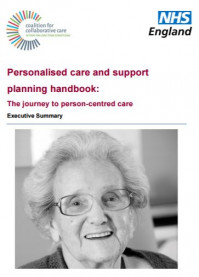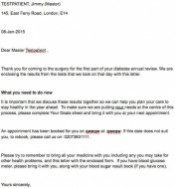| Ashing KT, Lai L, Brown S, et al. Developing a treatment summary and survivorship care plan responsive to African-American breast cancer survivors. Psychooncology. August 2015. doi:10.1002/pon.3939. |
| Bal Ozkaptan B, Kapucu S. Home nursing care with the self-care model improves self-efficacy of patients with chronic obstructive pulmonary disease. Jpn J Nurs Sci. January 2016. doi:10.1111/jjns.12118. |
| Banerjee SC, Matasar MJ, Bylund CL, et al. Survivorship care planning after participation in communication skills training intervention for a consultation about lymphoma survivorship. Transl Behav Med. 2015;5(4):393-400. doi:10.1007/s13142-015-0326-z. |
| Battersby M, Von Korff M, Schaefer J, et al. Twelve evidence-based principles for implementing\rself-management support in primary care. Jt Comm J Qual Patient Saf. 2010;36(12):561-570. |
| Blom J, den Elzen W, van Houwelingen AH, et al. Effectiveness and cost-effectiveness of a proactive, goal-oriented, integrated care model in general practice for older people. A cluster randomised controlled trial: Integrated Systematic Care for older People-the ISCOPE study. Age Ageing. 2016;45(1):30-41. doi:10.1093/ageing/afv174. |
| Bodenheimer T, Ghorob A, The GK, Med F. Building blocks of primary care assessment BBPCA. Ann Fam Med. 2014;12(2):166-171. |
| British Columbia Ministry of Health. Primary Health Care Charter: A Collaborative Approach.; 2007. |
| British Columbia Ministry of Health. Self-Management Support : A Health Care Intervention. 2011:1-66. http://www.selfmanagementbc.ca/uploads/What is Self-Management/PDF/Self-Management Support A health care intervention 2011.pdf. |
| Chen M-F, Wang R-H, Lin K-C, Hsu H-Y, Chen S-W. Efficacy of an empowerment program for Taiwanese patients with type 2 diabetes: A randomized controlled trial. Appl Nurs Res. 2015;28(4):366-373. doi:10.1016/j.apnr.2014.12.006. |
| Chen RC, Hoffman KE, Sher DJ, et al. Development of a standard survivorship care plan template for radiation oncologists. Pract Radiat Oncol. October 2015. doi:10.1016/j.prro.2015.10.001. |
| Clark-Wilson J, Holloway M. Life care planning and long-term care for individuals with brain injury in the UK. NeuroRehabilitation. 2015;36(3):289-300. doi:10.3233/NRE-151217. |
| Cohen DJ, Davis M, Balasubramanian BA, et al. Integrating Behavioral Health and Primary Care: Consulting, Coordinating and Collaborating Among Professionals. J Am Board Fam Med. 2015;28 Suppl 1:S21-S31. doi:10.3122/jabfm.2015.S1.150042. |
| Cole E. Cancer survivors inspire self-care plan. Nurs Stand. 2015;30(4):19-21. doi:10.7748/ns.30.4.19.s21. |
| Coleman EA, Roman SP, Hall KA, Min S-J. Enhancing the care transitions intervention protocol to better address the needs of family caregivers. J Healthc Qual. 2015;37(1):2-11. doi:10.1097/01.JHQ.0000460118.60567.fe. |
| Coulter A, Entwistle VA, Eccles A, et al. Personalised care planning for adults with chronic or long-term health conditions. Cochrane database Syst Rev. 2015;3(3). doi:10.1002/14651858.CD010523.pub2. |
| Day SM, Reynolds RJ, Kush SJ. The relationship of life expectancy to the development and valuation of life care plans. NeuroRehabilitation. 2015;36(3):253-266. doi:10.3233/NRE-151214. |
| de Britto FA, Martins TB, Landsberg GAP. Impact of a mobile health aplication in the nursing care plan compliance of a home care service in Belo Horizonte, Minas Gerais, Brazil. Stud Health Technol Inform. 2015;216:895. |
| de Iongh A, Fagan P, Fenner J, Kidd L. A Practical Guide to Self-Management Support. Key Components for Successful Implementation.; 2015. http://www.health.org.uk/sites/default/files/APracticalGuideToSelfManagementSupport.pdf. |
| Dening KH. Advance care planning in dementia. Nurs Stand. 2015;29(51):41-46. doi:10.7748/ns.29.51.41.e10060. |
| Evangelista EJ, James J, Deveny E. Implementing Anticipatory Care Plans in general practice: a practice approach to improving the health literacy of the community and reducing reliance on emergency services during after-hour periods. Aust J Prim Health. October 2015. doi:10.1071/PY15045. |
| Fiesseler F, Riggs R, Salo D, Klemm R, Flannery A, Shih R. Care plans reduce ED visits in those with drug-seeking behavior. Am J Emerg Med. 2015;33(12):1799-1801. doi:10.1016/j.ajem.2015.08.038. |
| Flanagan P, Moffat J, Healey K, Moffitt A. Learnings from a project to develop a generic self-management care plan for long term conditions. 2014;(June 2014). |
| Gale C. Assisting patients with motor neurone disease to make decisions about their care. Int J Palliat Nurs. 2015;21(5):251-255. doi:10.12968/ijpn.2015.21.5.251. |
| Hailemariam M, Fekadu A, Selamu M, et al. Developing a mental health care plan in a low resource setting: the theory of change approach. BMC Health Serv Res. 2015;15:429. doi:10.1186/s12913-015-1097-4. |
| Hird AE, Lemke M, Turovsky M, et al. Doctor, what are my options? A prospective cohort study of an individualized care plan for patients with gastrointestinal cancer. Curr Oncol. 2015;22(3):e171-e177. doi:10.3747/co.22.2194. |
| Ho J, Kuluski K, Gill A. A Patient-Centered Transitions Framework for Persons With Complex Chronic Conditions. Care Manag journals J case Manag ; J long term home Heal care. 2015;16(3):159-169. doi:10.1891/1521-0987.16.3.159. |
| Hoogendijk EO, van der Horst HE, van de Ven PM, et al. Effectiveness of a Geriatric Care Model for frail older adults in primary care: Results from a stepped wedge cluster randomized trial. Eur J Intern Med. 2016;28:43-51. doi:10.1016/j.ejim.2015.10.023. |
| Horsburgh MP, Bycroft JJ, Goodyear-Smith FA, et al. The Flinders Program of chronic condition self-management in New Zealand: Survey findings. J Prim Health Care. 2010;2(4):288-293. |
| Horsburgh MP, Bycroft JJ, Mahony FM, et al. The feasibility of assessing the Flinders Program of patient self-management in New Zealand primary care settings. J Prim Health Care. 2010;2(4):294-302. |
| Huebsch JA, Kottke TE, McGinnis P, et al. A qualitative study of processes used to implement evidence-based care in a primary care practice. Fam Pract. 2015;32(5):578-583. doi:10.1093/fampra/cmv045. |
| Iannuzzi D, Kopecky K, Broder-Fingert S, Connors SL. Addressing the Needs of Individuals with Autism: Role of Hospital-Based Social Workers in Implementation of a Patient-Centered Care Plan. Health Soc Work. 2015;40(3):245-248. |
| Jha B, Seavy J, Young D, Bonner A. Positive Mental Health Outcomes in Individuals with Dementia: The Essential Role of Cultural Competence. Online J Issues Nurs. 2015;20(1):5. |
| Johnson CB, Lacerte M, Fountaine JD. Certification standards of professionals coordinating life care plans for individuals who have acquired brain injury. NeuroRehabilitation. 2015;36(3):235-241. doi:10.3233/NRE-151212. |
| Mastellos N, Care P, Health P, Health P. Integrated Care Case Assessing patients ’ experience of integrated care : a survey of. 2014;14(June):1-9. |
| Matthie N, Jenerette C. Sickle cell disease in adults: developing an appropriate care plan. Clin J Oncol Nurs. 2015;19(5):562-567. |
| McManus M, White P, Pirtle R, Hancock C, Ablan M, Corona-Parra R. Incorporating the Six Core Elements of Health Care Transition Into a Medicaid Managed Care Plan: Lessons Learned From a Pilot Project. J Pediatr Nurs. 2015;30(5):700-713. doi:10.1016/j.pedn.2015.05.029. |
| Morello RT, Barker AL, Watts JJ, Bohensky MA, Forbes AB, Stoelwinder J. A Telephone Support Program to Reduce Costs and Hospital Admissions for Patients at Risk of Readmissions: Lessons from an Evaluation of a Complex Health Intervention. Popul Health Manag. August 2015. doi:10.1089/pop.2015.0042. |
| Morgan MA, Coates MJ, Dunbar JA. Using care plans to better manage multimorbidity. Australas Med J. 2015;8(6):208-215. doi:10.4066/AMJ.2015.2377. |
| Nolte L, Kinnane N, Lai-Kwon J, Gates P, Shilkin P, Jefford M. The Impact of Survivorship Care Planning on Patients, General Practitioners, and Hospital-Based Staff. Cancer Nurs. December 2015. doi:10.1097/NCC.0000000000000329. |
| Nzirawa T. Caring for children with complex needs. Nurs Manag (Harrow). 2015;22(5):32-38. doi:10.7748/nm.22.5.32.e1390. |
| O’Brien S, Edge N, Clark S. A strategy to reposition the South Australian health system for quality and value. Aust J Prim Health. November 2015. doi:10.1071/PY15038. |
| Poder U, Dahm MF, Karlsson N, Wadensten B. Standardised care plans for in hospital stroke care improve documentation of health care assessments. J Clin Nurs. 2015;24(19-20):2788-2796. doi:10.1111/jocn.12874. |
| Purdy S, Paranjothy S, Huntley A, et al. Interventions to reduce unplanned hospital admission. NIHR RfPB. 2012;(June). http://www.bris.ac.uk/primaryhealthcare/docs/projects/unplannedadmissions.pdf. |
| Quan J, Lee AK, Handley MA, et al. Automated Telephone Self-Management Support for Diabetes in a Low-Income Health Plan: A Health Care Utilization and Cost Analysis. Popul Health Manag. 2015;18(6):412-420. doi:10.1089/pop.2014.0154. |
| Quan J, Lee AK, Handley MA, et al. Automated Telephone Self-Management Support for Diabetes in a Low-Income Health Plan: A Health Care Utilization and Cost Analysis. Popul Health Manag. 2015;18(6):412-420. doi:10.1089/pop.2014.0154. |
| Ratanawongsa N, Handley MA, Sarkar U, et al. Diabetes health information technology innovation to improve quality of life for health plan members in urban safety net. J Ambul Care Manage. 2014;37(2):127-137. doi:10.1097/JAC.0000000000000019. |
| Ratanawongsa N, Karter AJ, Quan J, et al. Reach and Validity of an Objective Medication Adherence Measure Among Safety Net Health Plan Members with Diabetes: A Cross-Sectional Study. J Manag care Spec Pharm. 2015;21(8):688-698. |
| Registered Nurses’ Associaton of Ontario. Strategies to Support Self-Management in Chronic Conditions : Collaboration. Regist Nurses’ Assoc Ontario. 2010;(September):1-93. |
| Ritchie C, Andersen R, Eng J, et al. Implementation of an Interdisciplinary, Team-Based Complex Care Support Health Care Model at an Academic Medical Center: Impact on Health Care Utilization and Quality of Life. PLoS One. 2016;11(2):e0148096. doi:10.1371/journal.pone.0148096. |
| Silva RLDT, Barreto M da S, Arruda GO de, Marcon SS. Evaluation of the care program implementation to people with high blood pressure. Rev Bras Enferm. 2016;69(1):79-87. doi:10.1590/0034-7167.2016690111i. |
| Simpson A, Hannigan B, Coffey M, et al. No Title. Southampton (UK); 2016. doi:10.3310/hsdr04050. |
| Thoonsen B, Vissers K, Verhagen S, et al. Training general practitioners in early identification and anticipatory palliative care planning: a randomized controlled trial. BMC Fam Pract. 2015;16(1):126. doi:10.1186/s12875-015-0342-6. |
| Turner J, Yates P, Kenny L, et al. The ENHANCES study--Enhancing Head and Neck Cancer patients’ Experiences of Survivorship: study protocol for a randomized controlled trial. Trials. 2014;15:191. doi:10.1186/1745-6215-15-191. |
| Vogel L. Canadians want seniors care plan. CMAJ. 2015;187(13):E407. doi:10.1503/cmaj.109-5134. |
| Von Korff M, Turner JA, Shortreed SM, et al. Timeliness of Care Planning upon Initiation of Chronic Opioid Therapy for Chronic Pain. Pain Med. December 2015. doi:10.1093/pm/pnv054. |
| Wong CM, Wu SY, Ting WH, Ho KH, Tong LH, Cheung NT. An Electronic Nursing Patient Care Plan Helps in Clinical Decision Support. Stud Health Technol Inform. 2015;216:945. |
| Zwar N, Harris M, Griffiths R, et al. A systematic review of chronic disease management. Sydney Aust Prim Heal Care Inst. 2006;(September):67. http://files.aphcri.anu.edu.au/research/final_25_zwar_pdf_85791.pdf. |



 Within both community and specialist services, one systematic approach for care planning is the
Within both community and specialist services, one systematic approach for care planning is the 






